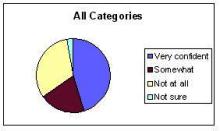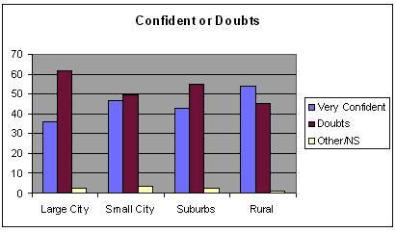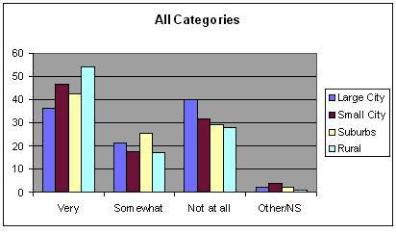By Michael Parenti
The 2004 presidential contest between Democratic challenger Senator John Kerry and the Republican incumbent, President Bush Jr., amounted to another stolen election. This has been well documented by such investigators as Rep. John Conyers, Mark Crispin Miller, Bob Fitrakis, Harvey Wasserman, Bev Harris, and others. Here is an overview of what they have reported, along with observations of my own.
Some 105 million citizens voted in 2000, but in 2004 the turnout climbed to at least 122 million. Pre-election surveys indicated that among the record 16.8 million new voters Kerry was a heavy favorite, a fact that went largely unreported by the press. In addition, there were about two million progressives who had voted for Ralph Nader in 2000 who switched to Kerry in 2004.
Yet the official 2004 tallies showed Bush with 62 million votes, about 11.6 million more than he got in 2000. Meanwhile Kerry showed only eight million more votes than Gore received in 2000. To have achieved his remarkable 2004 tally, Bush would needed to have kept all his 50.4 million from 2000, plus a majority of the new voters, plus a large share of the very liberal Nader defectors.
Nothing in the campaign and in the opinion polls suggest such a mass crossover. The numbers simply do not add up.
In key states like Ohio, the Democrats achieved immense success at registering new voters, outdoing the Republicans by as much as five to one. Moreover the Democratic party was unusually united around its candidate-or certainly against the incumbent president. In contrast, prominent elements within the GOP displayed open disaffection, publicly voicing serious misgivings about the Bush administration’s huge budget deficits, reckless foreign policy, theocratic tendencies, and threats to individual liberties.
Sixty newspapers that had endorsed Bush in 2000 refused to do so in 2004; forty of them endorsed Kerry.
All through election day 2004, exit polls showed Kerry ahead by 53 to 47 percent, giving him a nationwide edge of about 1.5 million votes, and a solid victory in the electoral college. Yet strangely enough, the official tally gave Bush the election. Here are some examples of how the GOP “victory” was secured.
—In some places large numbers of Democratic registration forms disappeared, along with absentee ballots and provisional ballots. Sometimes absentee ballots were mailed out to voters just before election day, too late to be returned on time, or they were never mailed at all.
—Overseas ballots normally reliably distributed by the State Department were for some reason distributed by the Pentagon in 2004. Nearly half of the six million American voters living abroad—a noticeable number of whom formed anti-Bush organizations—never received their ballots or got them too late to vote. Military personnel, usually more inclined toward supporting the president, encountered no such problems with their overseas ballots.
—Voter Outreach of America, a company funded by the Republican National Committee, collected thousands of voter registration forms in Nevada, promising to turn them in to public officials, but then systematically destroyed the ones belonging to Democrats.
— Tens of thousands of Democratic voters were stricken from the rolls in several states because of “felonies” never committed, or committed by someone else, or for no given reason. Registration books in Democratic precincts were frequently out-of-date or incomplete. —Democratic precincts—enjoying record turnouts—were deprived of sufficient numbers of polling stations and voting machines, and many of the machines they had kept breaking down. After waiting long hours many people went home without voting. Pro-Bush precincts almost always had enough voting machines, all working well to make voting quick and convenient.
—A similar pattern was observed with student populations in several states: students at conservative Christian colleges had little or no wait at the polls, while students from liberal arts colleges were forced to line up for as long as ten hours, causing many to give up.
—In Lucas County, Ohio, one polling place never opened; the voting machines were locked in an office and no one could find the key. In Hamilton County many absentee voters could not cast a Democratic vote for president because John Kerry’s name had been “accidentally” removed when Ralph Nader was taken off the ballot.
—A polling station in a conservative evangelical church in Miami County, Ohio, recorded an impossibly high turnout of 98 percent, while a polling place in Democratic inner-city Cleveland recorded an impossibly low turnout of 7 percent.
—Latino, Native American, and African American voters in New Mexico who favored Kerry by two to one were five times more likely to have their ballots spoiled and discarded in districts supervised by Republican election officials. Many were given provisional ballots that subsequently were never counted. In these same Democratic areas Bush “won” an astonishing 68 to 31 percent upset victory. One Republican judge in New Mexico discarded hundreds of provisional ballots cast for Kerry, accepting only those that were for Bush.
—Cadres of rightwing activists, many of them religious fundamentalists, were financed by the Republican Party. Deployed to key Democratic precincts, they handed out flyers warning that voters who had unpaid parking tickets, an arrest record, or owed child support would be arrested at the polls—all untrue. They went door to door offering to “deliver” absentee ballots to the proper office, and announcing that Republicans were to vote on Tuesday (election day) and Democrats on Wednesday.
—Democratic poll watchers in Ohio, Arizona, and other states, who tried to monitor election night vote counting, were menaced and shut out by squads of GOP toughs. In Warren County, Ohio, immediately after the polls closed Republican officials announced a “terrorist attack” alert, and ordered the press to leave. They then moved all ballots to a warehouse where the counting was conducted in secret, producing an amazingly high tally for Bush, some 14,000 more votes than he had received in 2000. It wasn’t the terrorists who attacked Warren County.
—Bush did remarkably well with phantom populations. The number of his votes in Perry and Cuyahoga counties in Ohio, exceeded the number of registered voters, creating turnout rates as high as 124 percent. In Miami County nearly 19,000 additional votes eerily appeared in Bush’s column after all precincts had reported. In a small conservative suburban precinct of Columbus, where only 638 people were registered, the touchscreen machines tallied 4,258 votes for Bush.
—In almost half of New Mexico’s counties, more votes were reported than were recorded as being cast, and the tallies were consistently in Bush’s favor. These ghostly results were dismissed by New Mexico’s Republican Secretary of State as an “administrative lapse.”
Exit polls showed Kerry solidly ahead of Bush in both the popular vote and the electoral college. Exit polls are an exceptionally accurate measure of elections. In the last three elections in Germany, for example, exit polls were never off by more than three-tenths of one percent.
Unlike ordinary opinion polls, the exit sample is drawn from people who have actually just voted. It rules out those who say they will vote but never make it to the polls, those who cannot be sampled because they have no telephone or otherwise cannot be reached at home, those who are undecided or who change their minds about whom to support, and those who are turned away at the polls for one reason or another.
Exit polls have come to be considered so reliable that international organizations use them to validate election results in countries around the world.
Republicans argued that in 2004 the exit polls were inaccurate because they were taken only in the morning when Kerry voters came out in greater numbers. (Apparently Bush voters sleep late.) In fact, the polling was done at random intervals all through the day, and the evening results were as much favoring Kerry as the early results.
It was also argued that pollsters focused more on women (who favored Kerry) than men, or maybe large numbers of grumpy Republicans were less inclined than cheery Democrats to talk to pollsters. No evidence was put forth to substantiate these fanciful speculations.
Most revealing, the discrepancies between exit polls and official tallies were never random but worked to Bush’s advantage in ten of eleven swing states that were too close to call, sometimes by as much as 9.5 percent as in New Hampshire, an unheard of margin of error for an exit poll. In Nevada, Ohio, New Mexico, and Iowa exit polls registered solid victories for Kerry, yet the official tally in each case went to Bush, a mystifying outcome.
In states that were not hotly contested the exit polls proved quite accurate. Thus exit polls in Utah predicted a Bush victory of 70.8 to 26.4 percent; the actual result was 71.1 to 26.4 percent. In Missouri, where the exit polls predicted a Bush victory of 54 to 46 percent, the final result was 53 to 46 percent.
One explanation for the strange anomalies in vote tallies was found in the widespread use of touchscreen electronic voting machines. These machines produced results that consistently favored Bush over Kerry, often in chillingly consistent contradiction to exit polls.
In 2003 more than 900 computer professionals had signed a petition urging that all touchscreen systems include a verifiable audit trail. Touchscreen voting machines can be easily programmed to go dead on election day or throw votes to the wrong candidate or make votes disappear while leaving the impression that everything is working fine.
A tiny number of operatives can easily access the entire computer network through one machine and thereby change votes at will. The touchscreen machines use trade secret code, and are tested, reviewed, and certified in complete secrecy. Verified counts are impossible because the machines leave no reliable paper trail.
Since the introduction of touchscreen voting, mysterious congressional election results have been increasing. In 2000 and 2002, Senate and House contests and state legislative races in North Carolina, Nebraska, Alabama, Minnesota, Colorado, and elsewhere produced dramatic and puzzling upsets, always at the expense of Democrats who were ahead in the polls.
In some counties in Texas, Virginia, and Ohio, voters who pressed the Democrat’s name found that the Republican candidate was chosen. In Cormal County, Texas, three GOP candidates won by exactly 18,181 votes apiece, a near statistical impossibility.
All of Georgia’s voters used Diebold touchscreen machines in 2002, and Georgia’s incumbent Democratic governor and incumbent Democratic senator, who were both well ahead in the polls just before the election, lost in amazing double-digit voting shifts.
This may be the most telling datum of all: In New Mexico in 2004 Kerry lost all precincts equipped with touchscreen machines, irrespective of income levels, ethnicity, and past voting patterns. The only thing that consistently correlated with his defeat in those precincts was the presence of the touchscreen machine itself.
In Florida Bush registered inexplicably sharp jumps in his vote (compared to 2000) in counties that used touchscreen machines.
Companies like Diebold, Sequoia, and ES&S that market the touchscreen machines are owned by militant supporters of the Republican party. These companies have consistently refused to implement a paper-trail to dispel suspicions and give instant validation to the results of electronic voting. They prefer to keep things secret, claiming proprietary rights, a claim that has been backed in court.
Election officials are not allowed to evaluate the secret software. Apparently corporate trade secrets are more important than voting rights. In effect, corporations have privatized the electoral system, leaving it easily susceptible to fixed outcomes. Given this situation, it is not likely that the GOP will lose control of Congress come November 2006. The two-party monopoly threatens to become an even worse one-party tyranny.
Michael Parenti’s recent books include The Assassination of Julius Caesar (New Press), Superpatriotism (City Lights), and The Culture Struggle (Seven Stories Press). For more information visit: www.michaelparenti.org.
from ZNet










